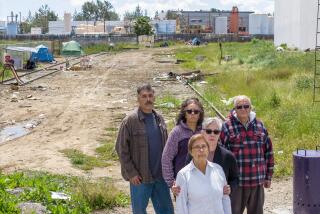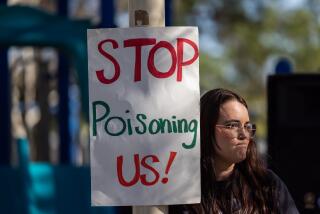Q&A: Complicated case of a leaky radioactive dump in New Mexico
The eruption in February of a 55-gallon drum of nuclear waste buried deep in a salt shaft at the Waste Isolation Pilot Plant near Carlsbad, N.M., has left the facility closed for months and raised questions about the Department of Energy’s ability to keep tabs on the content of nuclear waste containers buried at the site.
Some experts say that means the risk of additional eruptions is real. The incident this year wasn’t without consequences--21 workers were exposed to low-level doses of radiation. What’s the present level of risk?
Here’s what is known about the issue so far.
The Waste Isolation Pilot Plant (WIPP) is the nation’s only repository for certain types of nuclear waste resulting from the production of nuclear weapons. Why is it still shut down?
Investigators for the Energy Department have not been able to determine why a drum of radioactive waste stored 2,150 feet underground had a chemical reaction that released radioactivity. So far, nobody can say whether such an accident can occur with other drums containing the same kind of waste.
What kind of dump is it?
The plant is located in an ancient salt bed that was dug out just like a conventional salt mine. It is designed so that once it fills up and is plugged, the salt will slowly collapse around the waste and seal it for at least 10,000 years. So, the dump is designed so that no waste or radioactivity is supposed to escape.
Did anybody get hurt in the accident?
The radioactivity that was released traveled up a vent shaft and gave 21 workers on the surface small doses of radiation that were reportedly detected in urine and stool samples. The doses were extremely small, a fraction of the annual exposure of radioactivity that every person gets from space radiation that reaches Earth’s surface. But the workers are still being monitored.
If the doses were so small, why is the accident such a big deal?
The radiation was detected underground by an air monitor at 11:14 p.m. when no workers were in the mine shafts. If the accident had occurred during routine work hours, the exposures could have been much higher. In addition, other drums containing the same material may also have the same kind of reaction, so it is important to know what caused the chemical reaction and make sure it cannot happen again.
Can any kind of radioactive waste be put in WIPP?
The plant is designed to accept transuranic wastes, which are artificial elements such as plutonium created in the manufacturing of nuclear weapons. These wastes can have levels of radioactivity so low that workers can directly handle the steel drums, or moderate levels of radioactivity that require remote handling by machinery.
Can the waste from commercial nuclear reactors go to WIPP?
Spent fuel rods from power plants are very highly radioactive and so thermally hot from atomic decay that they must be immersed in cooling water for years after they come out of a reactor. Some experts believe that after they cool off, they also could be stored in salt deposits, but other experts say the heat would ultimately cause the salt to crack and allow water to penetrate to the waste. The water, if it flooded the waste, could allow the radioactivity to migrate into ground water.
If fuel rods cannot go to WIPP, where do they go?
There is no dump that accepts spent fuel rods. The Energy Department had planned to open a special repository for spent fuel at Yucca Mountain near Las Vegas, but the Obama adminstration has shut down the project. Nearly 70,000 metric tons of spent fuel is being stored at about 100 nuclear reactors around the nation.
How much waste was created in nuclear weapons production?
Tens of thousands of tons of waste exist all over the nation, awaiting treatment or disposal. Some of the waste has been shuttled from one site to another. Much of the transuranic waste from the former Rocky Flats plant in Colorado, where plutonium triggers were made, was trucked to Idaho. Under a legal agreement, the Energy Department was supposed to send that waste to New Mexico. Uranium wastes that were made in New York were sent to South Carolina, and now Energy Department officials are trying to send that waste to Nevada.
Are there any other radioactive dumps that are operating?
A few dumps take low-level radioactive wastes. A shallow pit at the Nevada National Security Site accepts certain kinds of federally owned wastes. Other low-level dumps are located in Utah and Texas.
Why can’t the U.S. shoot nuclear waste into space?
About 1% to 5% of all rockets malfunction on launch, meaning tons of radioactive debris would be spread all over Earth. The cost of launching this heavy material would also be prohibitive.
Did anybody think through the problems of dealing with nuclear waste before it was created?
The waste was created largely before the modern environmental movement began, when the practice was to simply dump the waste products into the ground without any consideration of the long-term impacts. More recently, government officials and utility executives have argued that they have the technology and science needed to safely dispose of newly made radioactive wastes from power plants.
More to Read
Start your day right
Sign up for Essential California for news, features and recommendations from the L.A. Times and beyond in your inbox six days a week.
You may occasionally receive promotional content from the Los Angeles Times.







